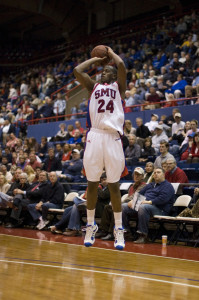Three Lower Body Problems and Solutions for a Players Shooting Action
The Shooting Action of a player is probably the most important skill a player must master when they start play basketball. The vast majority of players have a jump shot of some sort. Even those players who do not regularly use their shooting action in favour the lay-up, hook shot or other post moves still possess a capable jump shot, but just choose not to use it frequently. For perimeter players the need to have a strong shooting action is vital for reaching the higher levels of the sport. Very few players can be effective from on the three-point line without a jump shot that is serviceable from distance. The focus on having a variety of individual scoring options by players both in, and around the keyway as well as from the perimeter make a players shooting action probably the most important skill of all.

The first problem commonly seen is the ball falling short of the target. This can either been seen in the player shooting an “air ball” (missing the hoop completely) or by having their shot consistently hit the front of the hoop. A solution for this problem can be as simple as players having the player link the various body movements in their shooting action more seamlessly. This flow to a players shooting action will help generate a greater amount of power and ultimately help the player to lift the ball over the front of the basket and into the net.
Another common issue seen in a players shooting action is the over rotation of a players body. This twisting action sometimes seen in a player’s shot has a number of significant issues attached. Some of the more obvious problems will be a player pushing the ball to one side or the other of the basket. The solution for this problem is to help players with their footwork so they do not need to rotate their body so much to be able to aim easily. The dominate hand of the player should be mirrored by the foot on this same side of the body slight forward when compared to the opposite foot. By having the dominant foot a third, to half a length in front of the opposite foot the body will rotate slightly making it easier for the player to be able to look down the shooting arm. This will cause the player to reduce the amount of rotation they try to forcibly achieve by excessively rotating their torso to aim.
The final lower body problem to be explored in a players shooting action is the position of the feet too close together. The significance of this issue can be varied depending on how serve the problem is. For some players the problem will be so acute that they end up putting all the force onto one leg to generate the explosive power for their shooting action. This obviously increases the likelihood of injury and inconsistence of their shooting action. If the feet are positioned close while the pressure can be reduced, the ability to maintain balance when compared against the proper shooting action will be impaired. This lack of control with regards to balance will result in a player falling forward, backwards and every which way. The solution here is to have players practice maintaining a shoulder width of space between their feet. Players will need to practice both jump-stops and stride-stops so they become comfortable with using each technique. Following the implementation of these teaching points it then becomes a matter of practice, practice and practice some more.
Diagnosing the issue with a problem is only the starting point in help an individual improve their shooting action. In all of these instances, the repetition of the correct technique will be vital in making ongoing changes becoming lasting habits.








Top post. I look forward in order to reading much more. Cheers